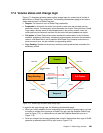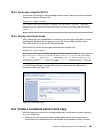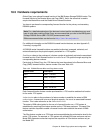206 IBM System Storage DS6000 Series: Copy Services with IBM System z
18.1 Global Copy basic options
First we review the basic options available when working with Global Copy. You will see that
many of these options are common to Metro Mirror. However, keep in mind that the results
may differ because Metro Mirror and Global Copy have differences in the way they work.
18.1.1 Establish Global Copy pair
This is the operation where you establish a Global Copy relationship between a primary
(source) and a secondary (target) volume—that is, you establish a Global Copy pair. During
this operation, the volumes will transition from the simplex state to the copy pending state.
When you establish a Global Copy pair, the following options are available:
No copy
This option does not copy data from the primary to the secondary volume. This option
assumes that the volumes are already synchronized. The data synchronization is your
responsibility and the DS6000 does not check its synchronization.
Targe t re ad
This option allows host servers to read from the secondary volume. In order for a host
server to read the volume, the volume pair must be in full duplex state. Note that this
parameter applies to open systems volumes; it does not apply to System z volumes.
Suspend after data synchronization
This option suspends the remote copy pairs after the data has been synchronized. You
can use this option with the Go-to-sync operation (the Go-to-sync operation is discussed
in 18.1.5, “Convert a Global Copy pair to Metro Mirror” on page 207).
Wait option
This option delays the command response until the volumes are in one of the final states:
simplex, full duplex, suspended, target full duplex, or target suspended. This parameter
cannot be used with -type gcp or -mode nocp, but it can be used with the Go-to-sync
operation.
Reset reserve on target
This option allows the establishment of a Global Copy relationship when the secondary
volume is reserved by another host. If this option is not specified and the secondary
volume is reserved, the command fails. This parameter can only be used with open
system volumes.
18.1.2 Suspend Global Copy pair
This operation stops copying data to the secondary volume and leaves the pair in suspended
state. Because the primary DS6000 keeps a record of all changed tracks on the primary
volume, you can resume the remote copy operation at a later time.
18.1.3 Resume Global Copy pair
This operation resumes a Global Copy relationship for a volume pair and starts to copy data
back again to the secondary volume. Only modified tracks are sent to the secondary volume,
because the DS6000 kept a record of all changed tracks on the primary volume while the
volumes were suspended. When resuming a Global Copy relationship, you can use the same
options you use to initially establish a Global Copy pair, except for the no copy option.


















